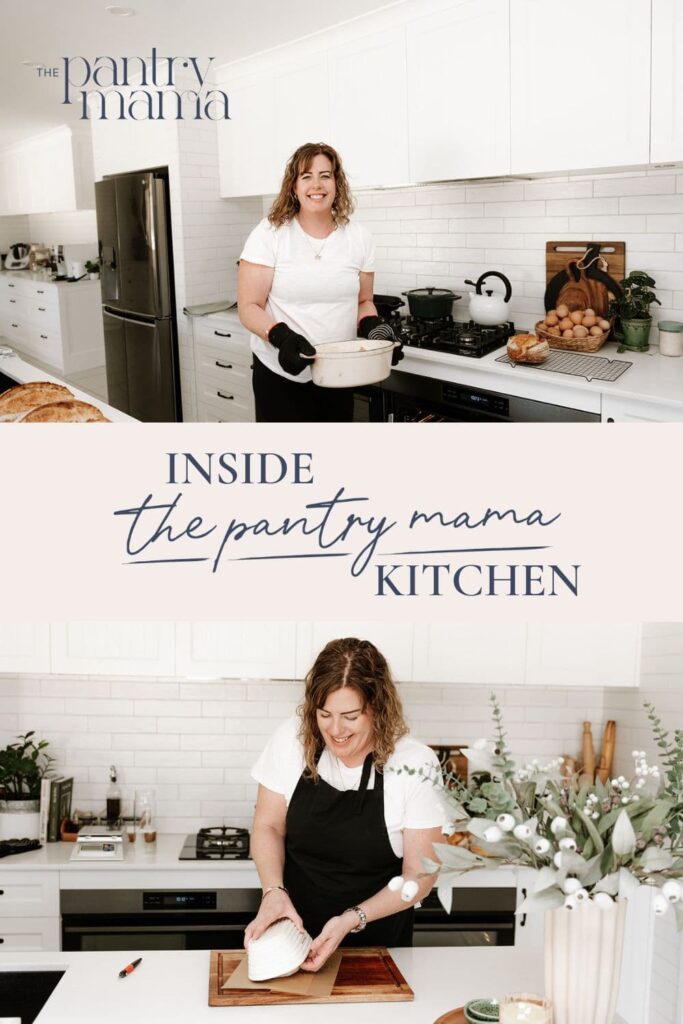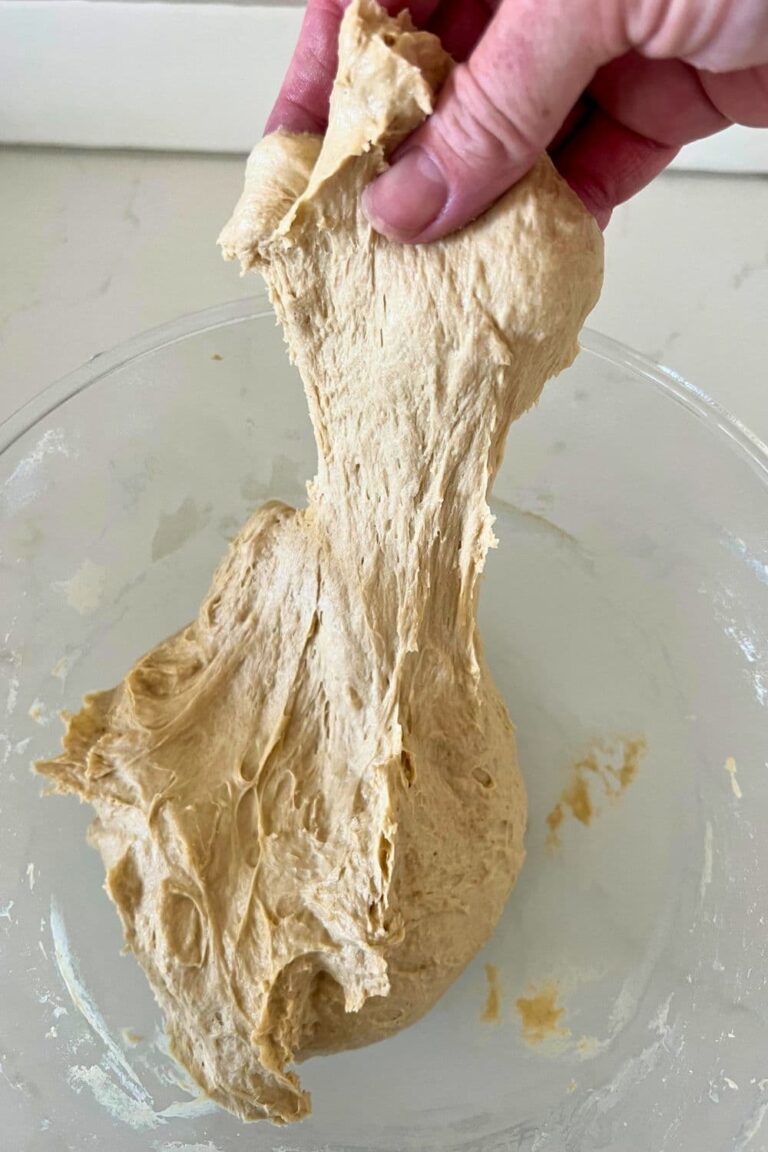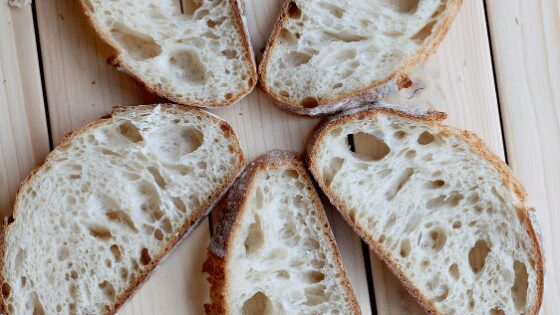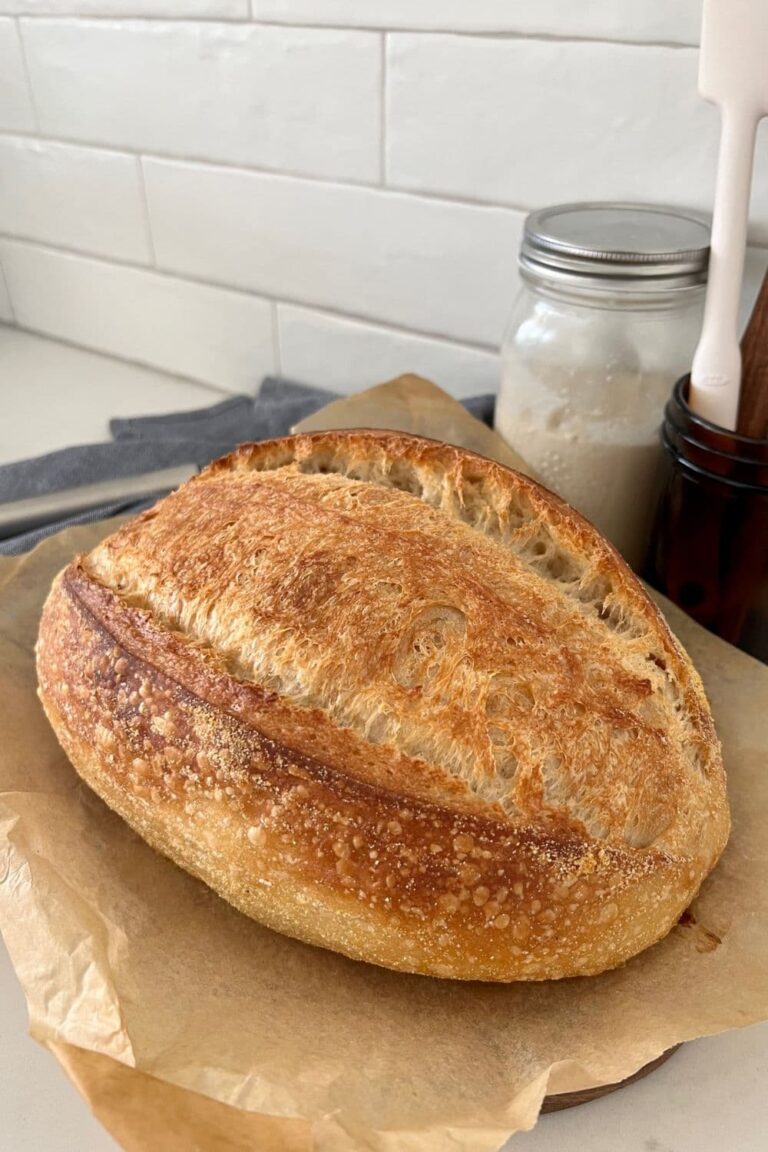Inside The Pantry Mama Test Kitchen
This post may contain affiliate links.
Step inside my sourdough kitchen, where flour dust lingers in the air, there's always something rising on the counter and something delicious in the oven! Oh and did I mention nerf bullets flying through the air?
I want to share the background to my sourdough bakes with you - the tools I use, the kitchen I bake in, the oven I use, the flour I use - how I feed my sourdough starter - so that you can understand the process of making sourdough more thoroughly.
I also get asked these questions a lot, so I thought having all the answers in one place would be helpful. You can see how I bake sourdough bread in my home kitchen, using basic ingredients - generally while my kids cause chaos around me!
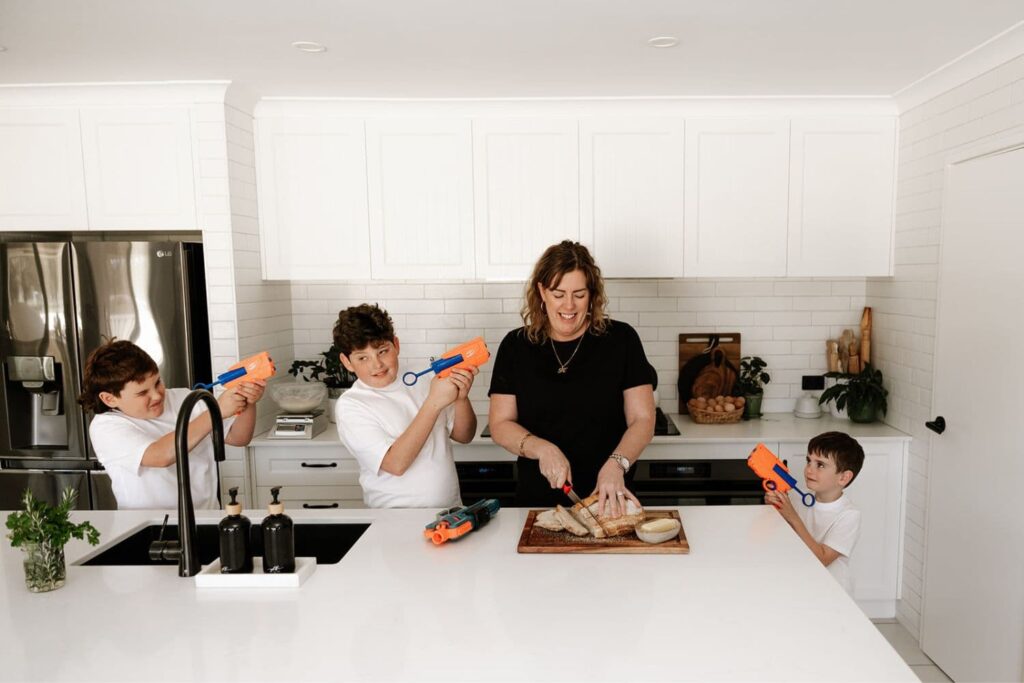
Ingredients Used In TPM Recipes
Here's the low down on the basic ingredients you will come across in my recipes (for consistency and quality):
Bread Flour - I always use good quality, unbleached bread flour for my sourdough bread. I always check the label of the flour I'm buying to ensure it's at least 12% protein (good bread flour is generally between 12% and 14% - read about how to calculate protein in flour). At the moment I'm loving Mauri Strong Baker's Flour, as well as the Organic Whole Wheat Flour from Wholegrain Milling Co. I don't stay true to one specific brand though and I do change things up as I find new flours and test them out.
If you are having trouble finding flour with a high enough protein level, or your sourdough mixture feels very wet, I recommend you look into using vital wheat gluten and diastatic malt powder to increase the quality of the flour you use. This can be a game changer if the flour you're using has a lower protein level.
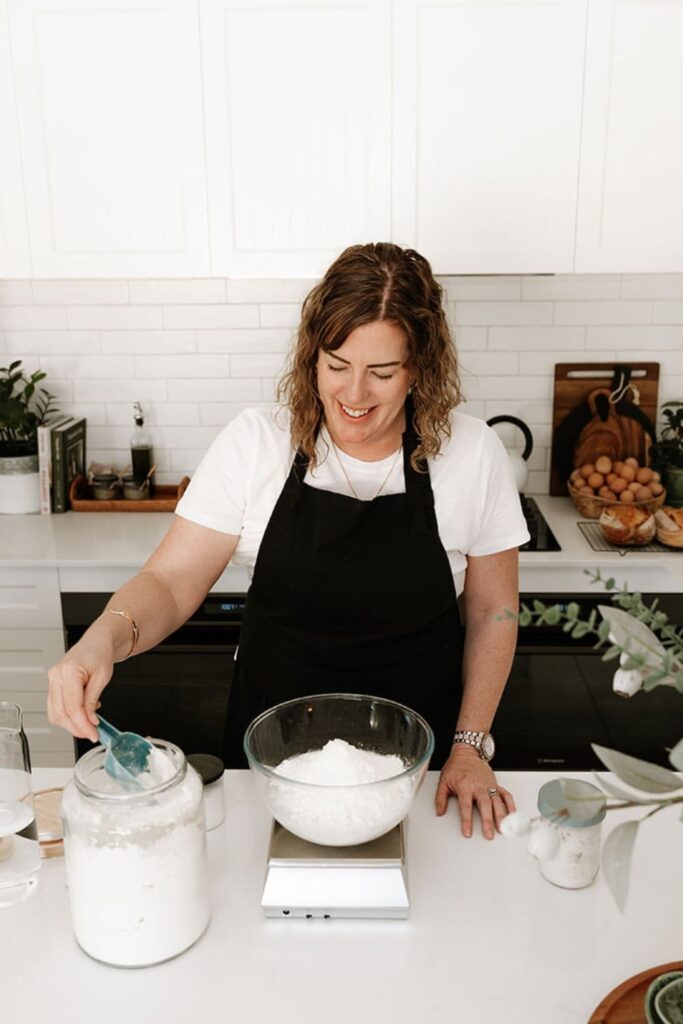
All Purpose Flour - for many sourdough discard recipes, I use generic All Purpose Flour (or plain flour) from the supermarket, nothing fancy. On average the all purpose flour I use has a protein content of 10%-11% but many flours in the US & Canada have a much higher protein level.
Salt - I'll be honest, I use whatever salt is within arms reach in my kitchen. Most of the time, that's a fine Australian sea salt, but sometimes it's pink salt. I never use iodised salt. I've written about the function of salt in sourdough bread.

Water - I live on a property where we have no mains water. I use rainwater that has been passed through a filter cartridge, as well as a UV filter to feed my sourdough starter and bake all of my sourdough bread. Read about the importance of water quality for sourdough bread.
As a side note, prior to having UV filters, our water was completely unfiltered and I used this in my sourdough with no issues.
Butter - I always use SALTED butter in my recipes unless I state otherwise. I love butter so I make my own homemade butter to slather on my sourdough bread, and of course use in my recipes. If you prefer to use unsalted butter, that's totally fine, it won't make a huge amount of difference to a recipe, so feel free to use it instead. I know a lot of people don't like using salted butter in baking, but it's a rule I'm willing to break pretty much always!
I love salted butter so much, I even use it in desserts like this sourdough cookie skillet and these sourdough brownies.
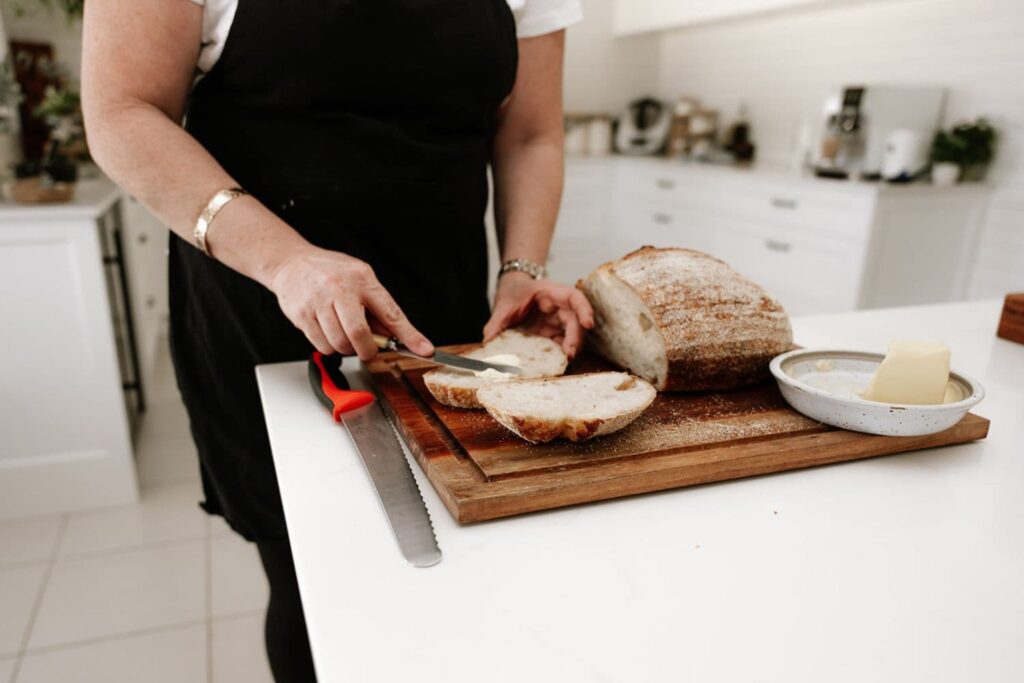
You might also see me mention cultured butter in some of my recipes. Cultured butter is made using cream that has been fermented with yogurt before making it into creamy butter. It tastes much like Irish butter and I highly recommend you try it if you haven't already.
Buttermilk - Some of my recipes use buttermilk. I generally have a jar of buttermilk in the fridge as a by product of making my own butter, however if I don't have any on hand, I will use the following alternative - 100g of whole milk with 15g of white vinegar stirred in. Let this sit for 5 to 10 minutes to thicken before using it as you would buttermilk.
Milk - I use whole dairy milk in my recipes. It's not fancy but it does the job. Many people ask whether non dairy milks work in the recipes I create. Sometimes I will test them and leave notes in the ingredient notes. Often if you check the comments on the recipe posts, you'll see that someone has tested the recipe with non dairy milk and left their results, so this can be helpful too if you're looking for non dairy milk alternatives.
White Sugar - I will generally use white sugar (which is also called granulated sugar) in recipes, unless stated otherwise. I don't use anything fancy, just basic store brand sugar. I do like using fine sugar (we call it caster sugar) when making things like sourdough brioche or this sourdough chocolate star. It's not powdered sugar, but it's not raw sugar, it's somewhere in between.
Brown Sugar - I use light brown sugar for the most part. If I've used dark brown sugar I will generally state it in the recipe, although it doesn't make too much difference. I do use molasses ocassionally, particularly for sourdough gingerbread cookies or sourdough gingerbread rolls. I do not use black strap molasses, just the liquid molasses that comes in a jar or squeezey bottle.
Eggs - I do love using eggs in my sourdough recipes where appropriate. We have around 30 chickens, so eggs are very plentiful in my house! My backyard chicken eggs are quite large, around 70g. If I feel that this affects a recipe, I will state that you should use an extra egg if your eggs are smaller. It's not a big deal, but always good to know, as eggs can vary in weight quite considerably. For example, my sourdough banana bread uses 2 large eggs. I've added a note in the recipe that if yours are small, I recommend using 3 eggs.
Semolina - if you've seen me make sourdough bread on Instagram or Tiktok, you might have noticed that I don't use rice flour. I prefer to line my bannetons with semolina. I always have semolina on hand for making sourdough pizza bases. I started using it inside my bannetons and prefer it because it's coarser than rice flour and I love the rustic feel it gives to my loaves. There's no problem using rice flour to stop your sourdough sticking to the banneton, I just prefer semolina.
Oven Settings
I bake using a regular electric home oven. The majority of the time, my sourdough bread is baked inside a Dutch Oven at 230C fan forced (450F) for the first 30 minutes and then 10 to 15 minutes at 210C (410F) with the lid off. My oven does have a steam setting, but I don't use it (unless I'm baking something like sourdough baguettes) because I prefer to bake sourdough inside a Dutch oven.
My recipes are written using a fan forced/convection oven (it's the default setting of my oven). Fan forced is the same as convection, so you might hear those two words used interchangeably.
If you are having trouble with bake times or temperatures, I highly recommend checking the temperature of your oven, particularly if it's older. Sometimes the temperature needs adjustment - or more realistically, you will have to adjust bake times to suit your oven. I know the hot spots in my oven, as well as when I need to turn things to ensure they don't catch in certain spots. The more you bake, the more you'll get to know your oven and how to use it more effectively.

I also use the defrost setting on my oven which sits at 30C (86F). This is really handy for the bulk fermentation of sourdough bread. I will place my dough in here, covered with an elastic food cover and let it ferment (as an alternative to using a bread proofer). While the dial says 30C (86F), it doesn't actually get to 30C (86F) inside - and I will often turn the setting off and just leave the door closed if I feel my dough is getting too warm.
If your oven has a bread proof setting, it can be worth experimenting with - just know that it's generally too warm for sourdough, so you might have to use it in short spurts like I have mentioned above or use a thermometer to measure how warm it actually gets.
Using a bread proofer is a much more accurate way to bulk ferment dough (I've written more about the bread proofer I use further down).
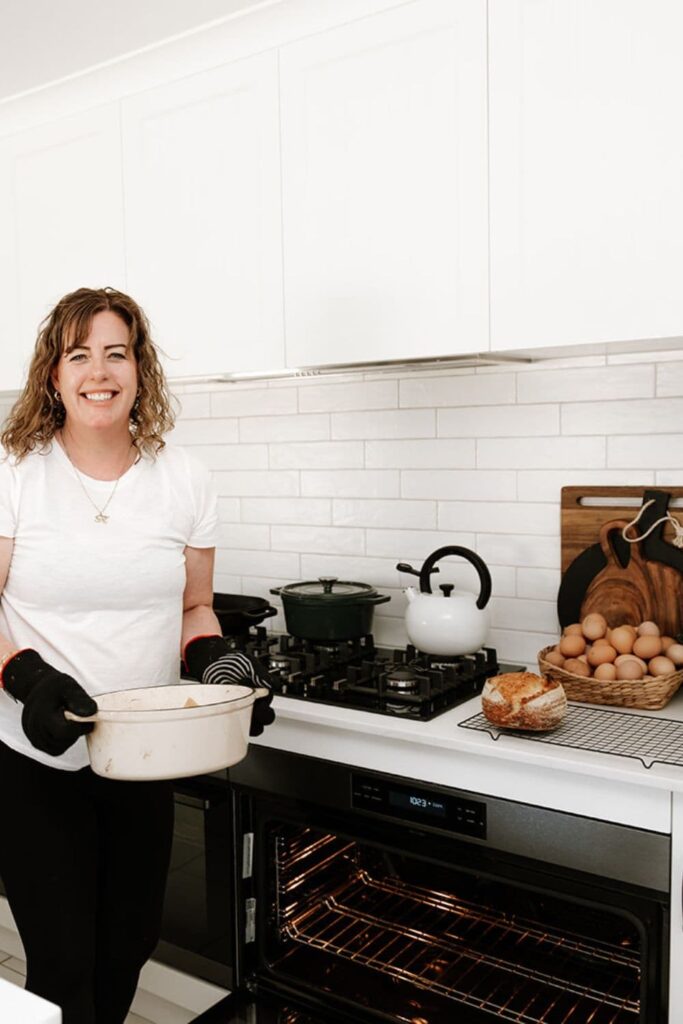
Fridge Temperatures
I have 2 fridges that I use for cold fermentation. One is set at 2C (35.6F) and the other at 3C (37.4F). There's not a huge amount of difference between these, however I will generally put loaves into the 3C fridge if I'm not concerned if they grow a little in the fridge. If I don't want them to rise any more, I'll use the 2C fridge.
This has taken a few years to get the hang of and work out how to navigate my fridge and the coldest and warmest spots inside my fridge.
I urge you to experiment with your fridge and see where the coldest spots and warmest spots are so you can better use it for more flexible cold proofing.
Temperature and Conditions
In summer, we have air conditioning which keeps the kitchen fairly cool. I also work on stone benchtops. For this reason, in the summer, I utilize the oven and also this Brod & Taylor Bread Proofer to regulate temperature.
In the winter months, we have a log fire which burns 24/7. This means that in the colder months, my kitchen is warmer and I don't generally need the oven or bread proofer to regulate temperature (although the stone bench tops do tend to stay quite cool regardless).
I do however have to adjust the amount of sourdough starter I use to mitigate the increase in temperature.
No matter what temperature your home is, there are ways to adjust your sourdough starter and dough to compensate. This is exactly what I do to get around whatever temperature I'm dealing with on that particular day. It's not always warm here (it actually gets really cold in the winter).
As an example, if I want to do an overnight ferment, I know our laundry room is the coolest part of the house in the summer months, so I will adjust the amount of starter down and then leave the dough on the tiled floor of the laundry room overnight so it won't over ferment.
My Sourdough Starter
I have a well established sourdough starter that I created from scratch many years ago. It always stays on the counter (although I do keep a back up in the fridge just in case). Oh and I have a lot of dehydrated sourdough starter in the pantry too! I feed my starter every single day (sometimes twice or more if I'm baking a lot).
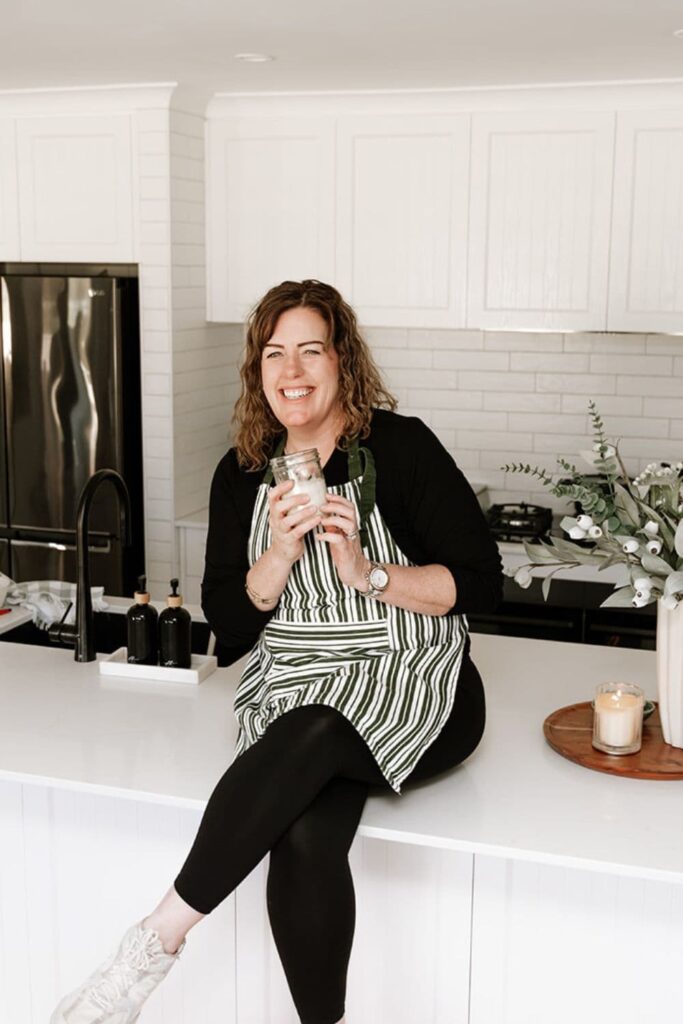
I've also purchased a Brod & Taylor Bread Proofer which my sourdough starter absolutely loves. If I am using the bread proofer to ferment my dough, then I will often pop my sourdough starter jar in there too, to give it a little boost (I generally set the proofer around 24C (75.2F) for my sourdough starter which keeps it pretty happy).
I feed my sourdough starter with bread flour (the same as above), however when I first made it, it was fed all purpose flour and rye flour ... and sometimes still gets a bit of rye here and there. My starter is fed at 100% hydration.
I often experiment with other sourdough starters and different flours, but my sourdough recipes are always made with this one, reliable sourdough starter and always at 100% hydration.
You can read more about how I feed my sourdough starter and sourdough starter ratios here.
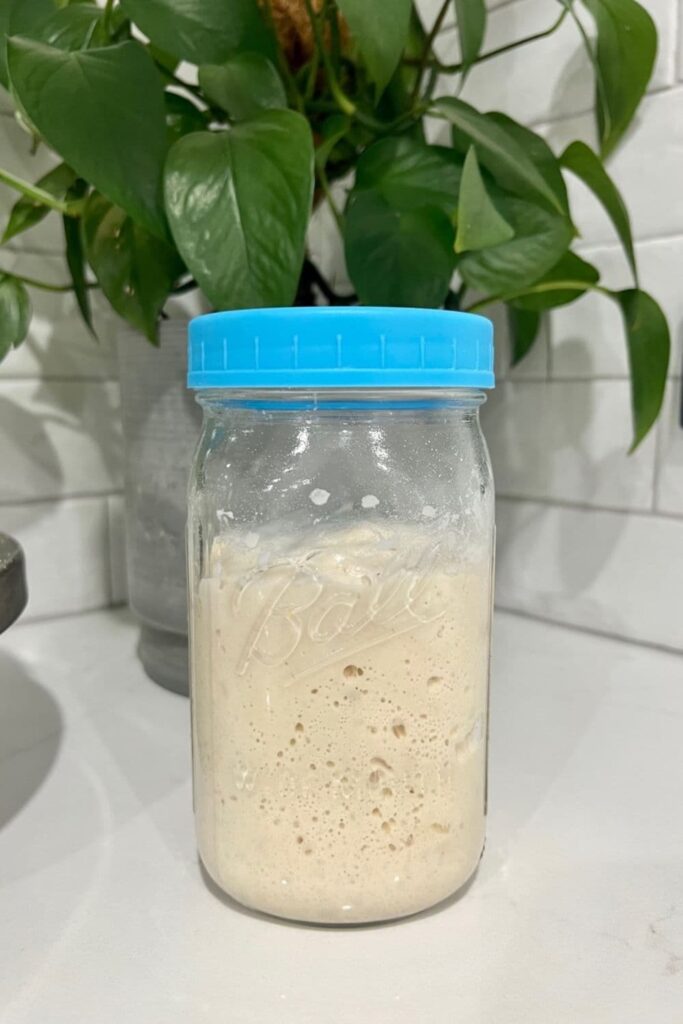
Why I Use A Scale
I use a digital baking scale to weigh all my sourdough ingredients because it is the most accurate way to measure (you can read about why weight is better for sourdough here). I love my KD-8000 (I upgraded to this scale after using a cheap scale for so long). The difference is amazing - the KD-8000 never shuts down or malfunctions. I will sometimes also use my Thermomix to weigh ingredients as it has a built-in scale.
The only time I use teaspoons to measure is for some spices that are too light to register on my scale (eg small amounts of cinnamon and nutmeg).
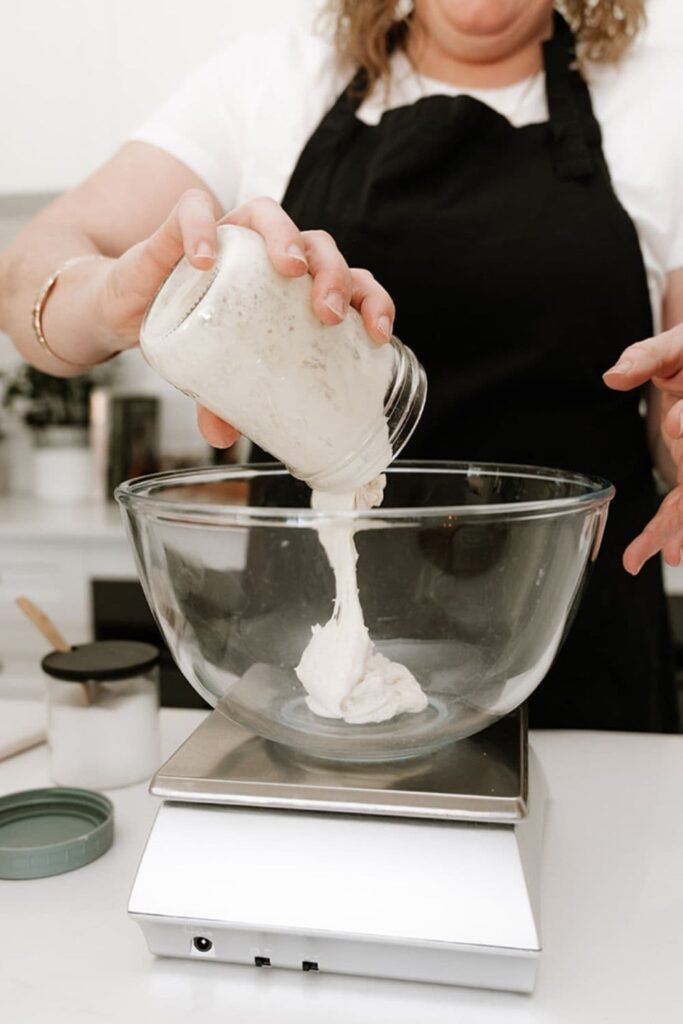
Other Sourdough Baking Equipment
I use a range of other equipment which I have detailed in the posts below:
I've also put together the Ultimate List of Sourdough Baking Equipment Here which goes through everything I use to bake sourdough bread in my kitchen - complete with photos of everything too!
These are standard items that you'll find in most of my bread recipes.
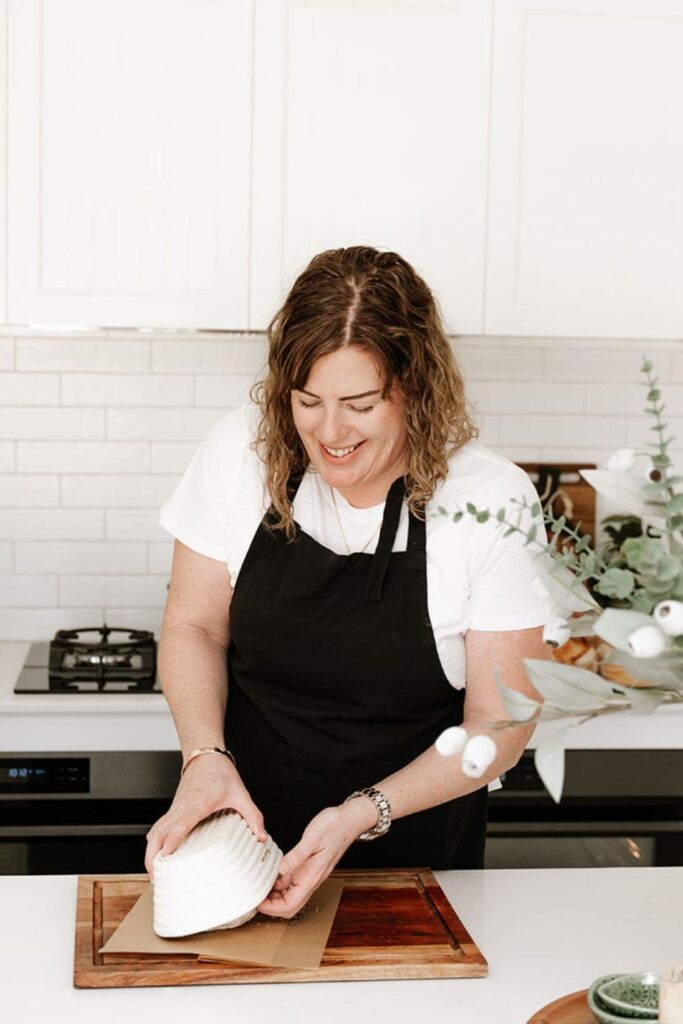
Mixing Machines
I have quite a few mixing machines on my kitchen counter. Majority of my recipes have been tested in both a KitchenAid Stand Mixer and a Thermomix (TM5 or TM6).
KitchenAid Stand Mixer
A lot of people ask about the KitchenAid in my kitchen so I thought I would include it here as well. It is a tilt head KSM195 in Matte Black. I use the glass bowl/jug more often than not - mostly because I like to see what's happening inside my bowl! This glass bowl is a genuine KitchenAid jug and was purchased separately to the mixer. It comes with a plastic lid which is really handy for covering dough while it is proofing or storing cookie dough in the fridge overnight.
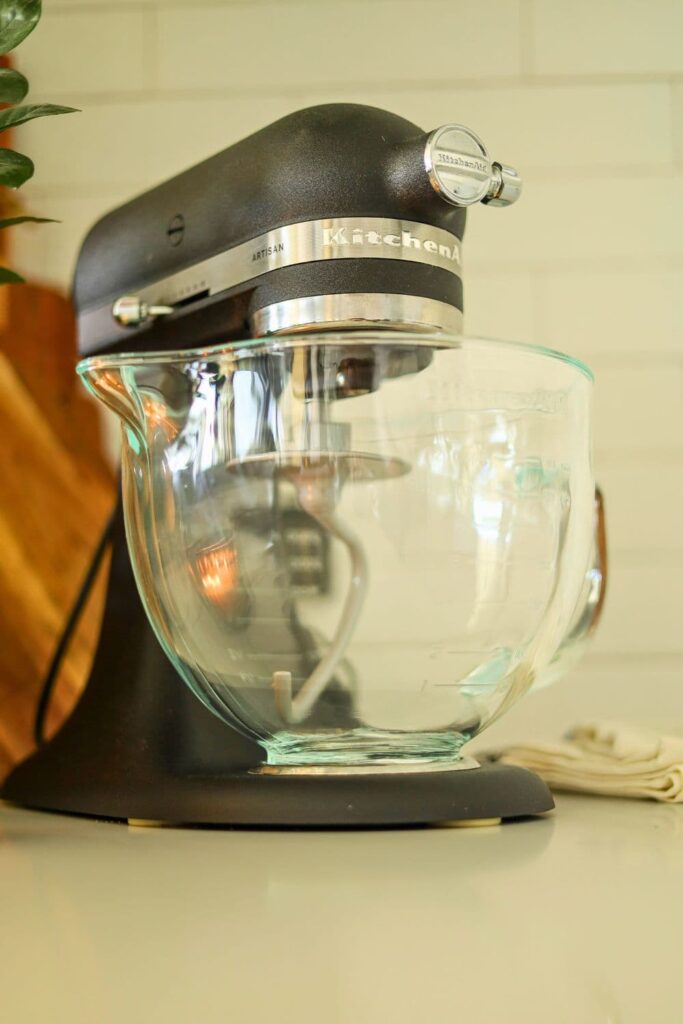
I have no problems kneading dough in my KitchenAid and often make single batches of sourdough discard pizza dough, sourdough discard sandwich bread or sourdough discard hamburger rolls with no issues. I find that using a recipe with 500g of flour is manageable for this machine.
Thermomix
I also use a Thermomix in my kitchen, currently a TM5 & TM6. I do use these a lot in my kitchen, not just for dough but for making sauces, making homemade butter, jams etc. They handle dough very well, although it's not as easy to clean as the KitchenAid. I've created a collection of Thermomix sourdough recipes specifically for the TM, but most recipes can be adapted.
The Thermomixes, like the KitchenAid, handle single batches of most recipes using 500g of flour.
Ankarsrum Assistent
I've recently invested in an Ankarsrum mixer and have found this is a game changer for making triple batches of my sourdough discard pizza dough and sourdough discard sandwich bread (I use the bread roller for both of these). As I use this machine more, I will update my recipes where I have tested them out in the Ankarsrum Assistent.
My Coffee Machine
My coffee machine often gets featured in my social media videos (you can see it in action in this TikTok video) and it's something I get lots of questions about so I thought I'd list it here too. It's actually an essential part of The Pantry Mama test kitchen because without it, there'd be no sourdough lol (because I'd be too tired to make it lol).
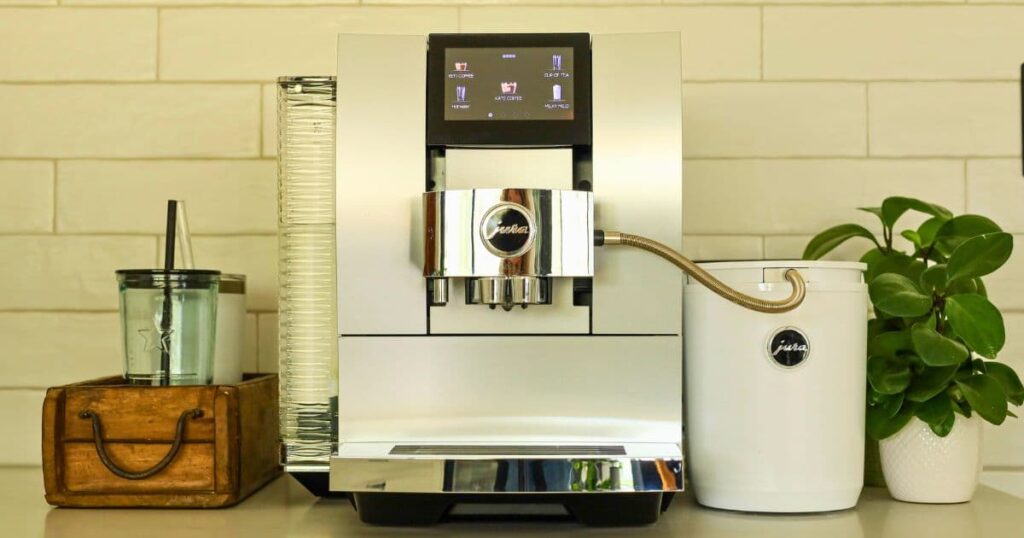
My coffee machine is a Jura Z10 Diamond White. We also have the optional Jura Cool Control Milk Container that keeps 1L of milk cold for extra convenience. This is a life saver when I'm in the kitchen all day as I can make coffee with just the touch of a button! I've got my favorite flat white programmed in with a double shot of espresso! I also use the coffee machine when I'm making my favorite loaf of sourdough with coffee and maple infused dates!
New To Sourdough?
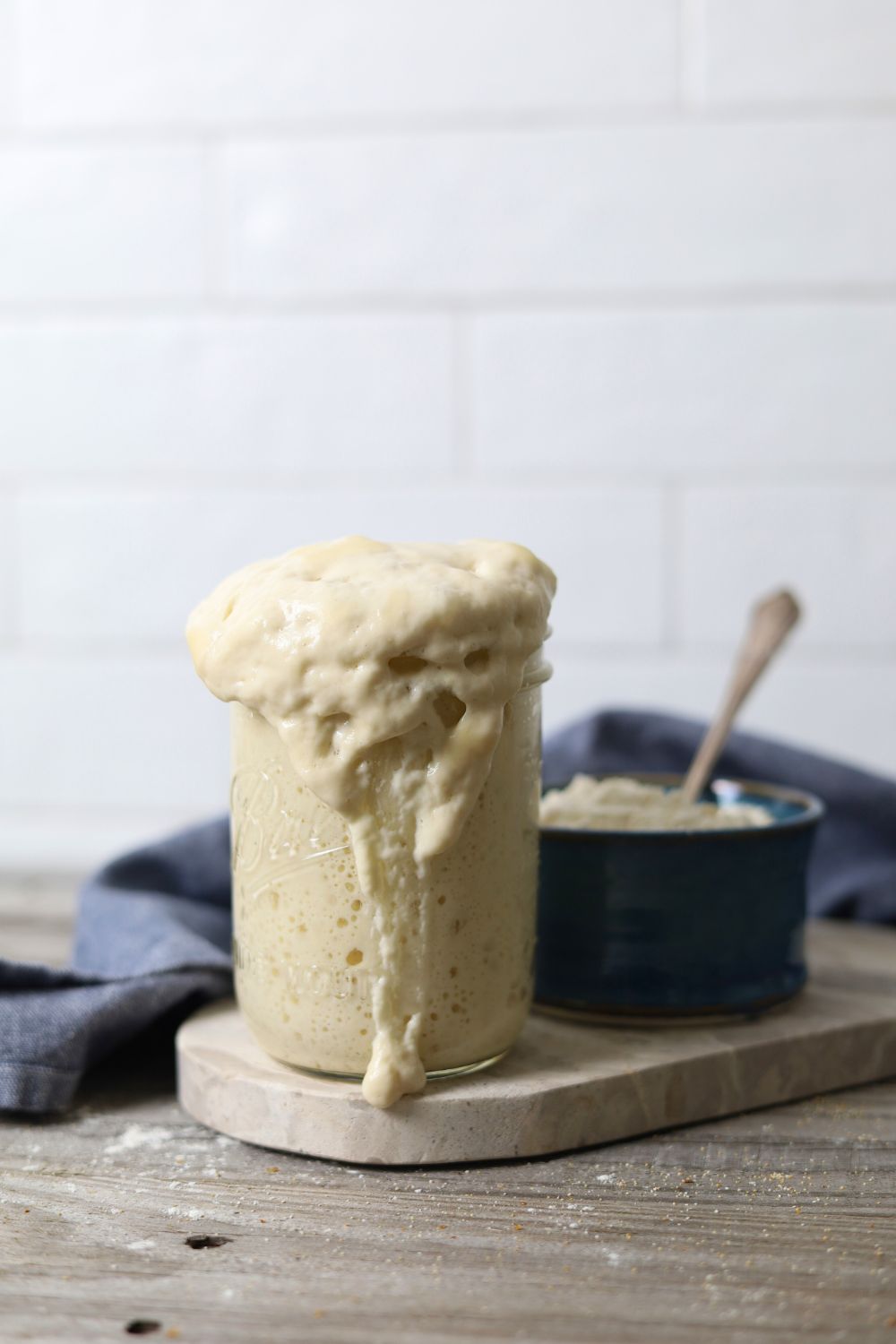
Create Your Own Sourdough Starter
Learn how to easily create & nurture your very own sourdough starter so you can start making delicious sourdough bread.
